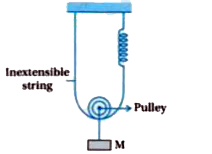A particle is in linear simple harmonic motion between two points. A and B, 10 cm apart (figure) take the direction from A to B as the positive direction and choose the correct statements.
 Solution in Gujrati
Solution in Gujrati
The sign of velocity, acceleration and force on the particle when it is 3cm away from a going towards B are positive.
The sign of velocity of the particle at C going towards B is negative.
The sign of velocity, acceleration and force on the particle when it is 4cm away from B going towards A are negative.
The sign of acceleration and force on the particle when it is at points B is negative.
The correct Answer is:A, C, D
When the particle is 3 cm away from A going towards B. So velocity is positive because direction from A to B is positive and acceleration is always towards mean position and so acceleration is positive and hence force is also positive. So statement A is correct.

When particle is at C, velocity is towards B hence positive. Hence, Statement B is incorrect.
When the particle is 4 cm away from B going towards a velocity is negative and acceleration is towards mean position hence negative so statement C is correct.
Acceleration is always towards mean position in SHM. When the particle is at B, acceleration and force are towards B to A that is negative. Hence, statement D is correct.
Topper's Solved these Questions
- BOOK - KUMAR PRAKASHANCHAPTER - OSCILLATIONSEXERCISE - SECTION-D (NCERT EXEMPLAR SOLUTION VERY SHORT ANSWER QUESTIONS)10videos
OSCILLATIONS
- BOOK - KUMAR PRAKASHANCHAPTER - OSCILLATIONSEXERCISE - SECTION-D (NCERT EXEMPLAR SOLUTION SHORT ANSWER QUESTIONS)6videos
OSCILLATIONS
- BOOK - KUMAR PRAKASHANCHAPTER - OSCILLATIONSEXERCISE - SECTION-D (NCERT EXEMPLAR SOLUTION MCQs)10videos
OSCILLATIONS
- BOOK - KUMAR PRAKASHANCHAPTER - OBJECTIVE QUESTIONS AS PER NEW PAPER STYLE EXERCISE - CHAPTER - 8 (Match Type questions)5videos
OBJECTIVE QUESTIONS AS PER NEW PAPER STYLE
- BOOK - KUMAR PRAKASHANCHAPTER - PHYSICAL WORLDEXERCISE - SECTION-E (QUESTIONS FROM MODULE)9videos
PHYSICAL WORLD
Similar Questions
Displacement versus time curve for a particle executing SHM is shown in figure. Idendify the points marked at which (i) velocity of the oscillator is zero, (ii) speed of the oscillator is maximum.
 06:48View Solution
06:48View SolutionFind the time period of mass M when displaced from its equilibrium position and then released for the system shown in figure.
 .03:35View Solution
.03:35View SolutionThe displacement of a particle represented by the equation y=3cos(π4−2ωt). The motion of the particle is
02:54View SolutionType of satellites are given in Column-I and their uses are given in Column-II. Match them properly :
Column-IColumn-II(1) Polar satellite(a) Tele communication(2) Geo-stationary satellite(b) Investigation(c) For information about atmosphere04:12View Solution.…. state of substance at very high temperature has generated hope of energy source for mankind.
02:12View SolutionA particle is in linear simple harmonic motion between two points A and B, 10 cm apart (figure) . Take the direction from A to B as the +ve direction and choose the correct statements.
 02:18View Solution
02:18View SolutionA particle is in linear simple harmonic motion between two points A and B 10cm apart (figure). Take the direction form A to B as positive direction and choose the correct statements. AO =OB = 5cm BC =8cm
02:10View SolutionA particle is in linear simple harmonic motion between two points. A and B, 10 cm apart (figure.) take direction from A to B as the positive direction and choose the correct statements. AO= OB= 5cm BC=8cm
02:03View SolutionA particle is in linear simple harmonic motion between two points A and B, 10 cm apart. Take the direction from A to B, as positive direction and give the signs of velocity and acceleration on the particle when it is (i) at the end B, (ii) at 3 cm away from A going towards B.
02:10View SolutionA particle is in linear simple harmonic motion between two points, A and B, 10 cm apart. Take the direction from A to B as the positive direction and give the signs of velocity, acceleration and force on the particle when it is at the end B.
View SolutionA particle is in linear simple harmonic motion between two points, A and B, 10 cm apart. Take the direction from A to B as the positive direction and give the signs of velocity, acceleration and force on the particle when it is
at 4 cm away from B going towards A.02:11View SolutionA particle is in linear simple harmonic motion between two points, A and B, 10 cm apart. Take the direction from A to B as the positive direction and give the signs of velocity, acceleration and force on the particle when it is at the end A.
01:56View SolutionA particle is in linear simple harmonic motion between two points, A and B, 10 cm apart. Take the direction from A to B as the positive direction and give the signs of velocity, acceleration and force on the particle when it is
at the end B.View SolutionA particle is in linear simple harmonic motion between two points, A and B, 10 cm apart. Take the direction from A to B as the positive direction and give the signs of velocity, acceleration and force on the particle when it is
at the end A.View SolutionA particle is in linear simple harmonic motion between two points, A and B, 10 cm apart. Take the direction from A to B as the positive direction and give the signs of velocity, acceleration and force on the particle when it is at the end B.
04:56View Solution

